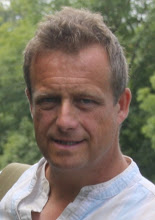Saturday, 6 December 2008
Hliterland
I wrote this in response to the landscapes of Litherland on Merseyside, a modern suburb with Norse roots. I ran a series of workshops to come up with ideas for the mural.
What is here today? A grey winter landscape, a tenacious urban suburb clinging to the swell of the docks, the thunder of road traffic, lorries, vans, a London landscape. Dusty concrete, litter, amputated and terraced streets, unexpected avenues of semis. Yet from the train there are trees and woods – overgrown nature parks, flooded allotments – abandoned attempts at leisure woodland, wild green space. And in the abandonment grand ideas are fulfilled; left alone nature creates a grey wooded landscape that cannot be radically dissimilar to the one that the Vikings saw from the river.
The Norse called it Hliterland, this fall of land from Hatton Hill. Did it then have an older name, a Gaelic name, unrecorded, forgotten? Were they watched from the trees, the newcomers with their dragon-ships – a grey morning, a sunny afternoon – when the Norse arrived for the first time and waded ashore, beaching the longboats for repairs? Unanswerable questions. Hliterland, the sloping place; the slope cut now, built over and sliced by docks, road, railway, canal, a crust of brick and concrete; but walkable still, this muscle-pulling hillside, up from the docks, the station, the lost shoreline. The road long-lost, if there ever was a path through trees to the hilltop. Today the path must be recut across tarmac and isolated cobbles, through an underpass, past too much dead land, land with no value. Tattersall and Seymour Streets, forgotten dignitaries with the names of disgraced conjurors. The Victorian suburb has in turn been hacked into chunks by roads for lorries heading for the docks; the walker comes across becalmed, silting stretches of respectable terraced housing, isolated from other streets by 1960s concrete. The unexpected majesty of the Red Lion public house, like a liner run ashore, well-maintained plaster ornament, crisp detail. The graffiti and indefinable menace of the canal. The ceaseless thunder of the road, like a mechanised Niagara.
Until the canal and the railway this was farming country, and after a thousand years the farms and cottages survived to be photographed on Moss Lane before falling, gently useless, to Victorian progress. Stone walls and stables survive on Field Lane, a path through the trees into Hatton Hill Park and the view back downhill to the river, a horizon of grain towers, cranes, wind turbines, tower blocks. The village survives in an echo, a row of shops on Sefton Street. And in place names; Field Lane, Wilson’s Lane, memories of fields and farms - and Moss Lane, the lane to the moss, the vast expanse of mere and fen covering much of southern Lancashire. A pattern of Norse settlers desperate for land, a pattern of villages that survives. Birkdale, Ormskirk, Toxteth. Are they here still? Are there sifts of Norse blood in these paint-spattered anxious children with their Irish names – Kara, Brendan, Caitlin, Kyle?
A different route down the hillside to the station, different cobbles, different tarmac. A small cluster of rusted street signs - Beach, Marina, Ocean – a yearning for the sea; as if the beaching of the dragon-ship was a regretted thing, that what should have been temporary became wrongly permanent, sea-warriors become farmers, settlers. A scattering of shell-names if this buried Norse village has been ashore too long, and longs once again for the open sea.
Subscribe to:
Post Comments (Atom)


No comments:
Post a Comment